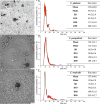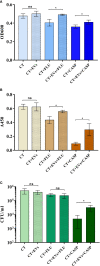Insight Into the Properties and Immunoregulatory Effect of Extracellular Vesicles Produced by Candida glabrata, Candida parapsilosis, and Candida tropicalis Biofilms
- PMID: 35734578
- PMCID: PMC9207348
- DOI: 10.3389/fcimb.2022.879237
Insight Into the Properties and Immunoregulatory Effect of Extracellular Vesicles Produced by Candida glabrata, Candida parapsilosis, and Candida tropicalis Biofilms
Abstract
Currently, non-albicans Candida species, including C. tropicalis, C. glabrata, and C. parapsilosis, are becoming an increasing epidemiological threat, predominantly due to the distinct collection of virulence mechanisms, as well as emerging resistance to antifungal drugs typically used in the treatment of candidiasis. They can produce biofilms that release extracellular vesicles (EVs), which are nanometric spherical structures surrounded by a lipid bilayer, transporting diversified biologically active cargo, that may be involved in intercellular communication, biofilm matrix production, and interaction with the host. In this work, we characterize the size and protein composition of these structures for three species of non-albicans Candida fungi forming biofilm, indicating considerable heterogeneity of the investigated population of fungal EVs. Examination of the influence of EVs on cytokine production by the human monocytic cell line THP-1 differentiated into macrophage-like cells revealed that the tested vesicles have a stimulating effect on the secretion of tumor necrosis factor α and interleukin 8, while they reduce the production of interleukin 10. This may indicate the proinflammatory nature of the effect of EVs produced by these species on the host immune cells. Moreover, it has been indicated that vesicles may be involved in C. tropicalis biofilm resistance to fluconazole and caspofungin. This reveals the important role of EVs not only in the physiology of C. tropicalis, C. glabrata, and C. parapsilosis fungi but also in the pathogenesis of infections associated with the production of fungal biofilm.
Keywords: biofilm; candidiasis; cytokines; extracellular vesicles; pathogenic fungi.
Copyright © 2022 Kulig, Karnas, Woznicka, Kuleta, Zuba-Surma, Pyza, Osyczka, Kozik, Rapala-Kozik and Karkowska-Kuleta.
Conflict of interest statement
The authors declare that the research was conducted in the absence of any commercial or financial relationships that could be construed as a potential conflict of interest.
Figures





Similar articles
-
Characteristics of Extracellular Vesicles Released by the Pathogenic Yeast-Like Fungi Candida glabrata, Candida parapsilosis and Candida tropicalis.Cells. 2020 Jul 18;9(7):1722. doi: 10.3390/cells9071722. Cells. 2020. PMID: 32708393 Free PMC article.
-
Candida and candidaemia. Susceptibility and epidemiology.Dan Med J. 2013 Nov;60(11):B4698. Dan Med J. 2013. PMID: 24192246 Review.
-
Biofilms of non-Candida albicans Candida species: quantification, structure and matrix composition.Med Mycol. 2009 Nov;47(7):681-9. doi: 10.3109/13693780802549594. Med Mycol. 2009. PMID: 19888800
-
In vitro evaluation of antibiotic lock technique for the treatment of Candida albicans, C. glabrata, and C. tropicalis biofilms.J Korean Med Sci. 2010 Dec;25(12):1722-6. doi: 10.3346/jkms.2010.25.12.1722. Epub 2010 Nov 24. J Korean Med Sci. 2010. PMID: 21165285 Free PMC article.
-
Candida glabrata, Candida parapsilosis and Candida tropicalis: biology, epidemiology, pathogenicity and antifungal resistance.FEMS Microbiol Rev. 2012 Mar;36(2):288-305. doi: 10.1111/j.1574-6976.2011.00278.x. Epub 2011 Jun 6. FEMS Microbiol Rev. 2012. PMID: 21569057 Review.
Cited by
-
Candida parapsilosis complex in the clinical setting.Nat Rev Microbiol. 2024 Jan;22(1):46-59. doi: 10.1038/s41579-023-00961-8. Epub 2023 Sep 6. Nat Rev Microbiol. 2024. PMID: 37674021 Review.
-
Isolation and Characteristics of Extracellular Vesicles Produced by Probiotics: Yeast Saccharomyces boulardii CNCM I-745 and Bacterium Streptococcus salivarius K12.Probiotics Antimicrob Proteins. 2024 Jun;16(3):936-948. doi: 10.1007/s12602-023-10085-3. Epub 2023 May 20. Probiotics Antimicrob Proteins. 2024. PMID: 37209320 Free PMC article.
-
Importance of Non-Covalent Interactions in Yeast Cell Wall Molecular Organization.Int J Mol Sci. 2024 Feb 21;25(5):2496. doi: 10.3390/ijms25052496. Int J Mol Sci. 2024. PMID: 38473742 Free PMC article. Review.
-
Caspofungin Affects Extracellular Vesicle Production and Cargo in Candida auris.J Fungi (Basel). 2022 Sep 21;8(10):990. doi: 10.3390/jof8100990. J Fungi (Basel). 2022. PMID: 36294557 Free PMC article.
-
Hidden allies: how extracellular vesicles drive biofilm formation, stress adaptation, and host-immune interactions in human fungal pathogens.mBio. 2024 Dec 11;15(12):e0304523. doi: 10.1128/mbio.03045-23. Epub 2024 Nov 18. mBio. 2024. PMID: 39555918 Free PMC article. Review.
References
-
- Albuquerque P., Nakayasu E., Rodrigues M. L., Frases S., Casadevall A., Zancope-Oliveira R. M., et al. . (2008). Vesicular Transport in Histoplasma Capsulatum: An Effective Mechanism for Trans-Cel Wall Transfer of Proteins and Lipids in Ascomycetes. Cell. Microbiol. 10 (8), 1695–1710. doi: 10.1111/j.1462-5822.2008.01160.x - DOI - PMC - PubMed
-
- Arendrup M. C. (2013). Candida and Candidaemia. Susceptibility and Epidemiology. Dan Med. J. 60 (11), B4698. - PubMed
Publication types
MeSH terms
Substances
LinkOut - more resources
Full Text Sources

